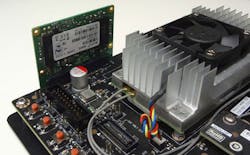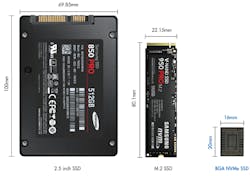This file type includes high resolution graphics and schematics when applicable.
Embedded developers have never had so many options when it comes to non-volatile, industrial-grade storage. Even the number of form factors is mind-boggling, ranging from conventional disk-drive formats—e.g., the now-ubiquitous 2.5-in. drives—to chips as well as modules like M.2.
Flash memory is the dominant storage mechanism, but alternatives like MRAM, FRAM, RRAM, and so on are growing in availability, performance, and capacity. Very ambitious developers might work directly with storage chips, but most developers will prefer to deal with storage that provides standard interfaces from SPI to PCI Express (PCIe), as well as variants like PCIe-based NVMe.
Even conventional interfaces and form factors like SATA-based, 2.5-in. solid-state drives are morphing into new configurations that work nicely with motherboards such as Virtium’s StorFly SATA modules (Fig. 1). This works nicely in the vertical orientation for a development board, though a production board would use a horizontal orientation that allows the module to be bolted down.
SATA, USB, and PCI Express tend to be the common interfaces for storage modules. I2C and SPI—including its variants, such as quad SPI (QSPI)—tend to address chip-based storage, although this is also changing in concert with rising capacity and performance demands. For example, Cypress Semiconductor’s serial HyperBus family runs at 333 MB/s using 12 pins.
Even storage chips are no longer limited to conventional parallel and serial interfaces. Samsung has NVMe-based chips that support NVMe (Fig. 2). The 512-GB PM971-NVMe utilizes Samsung’s 48-layer V-NAND, 4 Gb of LPDDR4 mobile memory, and Samsung’s controller. These are packed into a 20- by 16- by 1.5-mm BGA that weighs only one gram.
Developers need to take a number of factors into account—not just physical size or memory capacity. Performance is typically on the checklist, but application and data lifetimes matter. The latter can be more or less important depending on the technology employed. It is critical for flash storage, but less of an issue with technologies like MRAM.
Available interfaces often dictate what types of storage options are available to a developer. Even the DRAM sockets on many motherboards are candidates for non-volatile memory. Diablo Technologies has technology that allows all flash-memory DIMMs to plug into these sockets. These options are also changing how operating systems and applications deal with non-volatile storage. Looking at this storage in terms of block device interfaces is now only one option. Persistent memory is something that’s becoming more common.
This file type includes high resolution graphics and schematics when applicable.
About the Author
William Wong Blog
Senior Content Director
Bill's latest articles are listed on this author page, William G. Wong.
Bill Wong covers Digital, Embedded, Systems and Software topics at Electronic Design. He writes a number of columns, including Lab Bench and alt.embedded, plus Bill's Workbench hands-on column. Bill is a Georgia Tech alumni with a B.S in Electrical Engineering and a master's degree in computer science for Rutgers, The State University of New Jersey.
He has written a dozen books and was the first Director of PC Labs at PC Magazine. He has worked in the computer and publication industry for almost 40 years and has been with Electronic Design since 2000. He helps run the Mercer Science and Engineering Fair in Mercer County, NJ.
- Check out more articles by Bill Wong on Electronic Design
- Bill Wong on Facebook
- @AltEmbedded on Twitter




